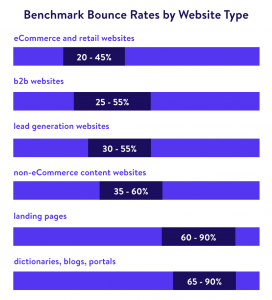Bounce rate is a critical factor in evaluating the amount of interaction that the user has with your landing pages. This factor in Google Analytics shows the percentage of users who entered a website and left without any interaction with the total number of users who visited that page. In simpler terms, it means how much of the audience that entered your page left without interaction. Bounce rate is one of the quantitative Metrics of Google Analytics to check the behavior of visitors to a landing page. Considering this criterion and several other criteria, such as the time spent on the page (Session Duration) and the exit rate (Exit Rate), can give us a good view of how users interact with the landing page. In this article on the smart strategy, we introduce what is the bounce rate in google analytics and how to reduce it.
Why is the bounce rate significant?
There are no specific criteria for determining the optimal bounce rate because different sites pursue different goals from users entering their pages. You can reduce the bounce rate with the help of Google Tag Manager. However, the high bounce rate can be a warning for you. A high bounce rate means that the number of users who have not engaged with your page increases. Therefore, the probability of these users returning to your site decreases similarly.
What are the reasons for the high bounce rate of google analytics?
Users who do not communicate and interact with your website are not engaged with your content. Therefore, it is better to first look at the table below and if you have a bounce rate higher than this value, analyze the reasons for this reluctance of the audience to interact more. These reasons cover a wide range, from the site’s appearance to the page loading speed. The best way to investigate these reasons is to put yourself in the user’s shoes and see what points on the target page discourage you from communicating more.
The first time a user encounters your landing page is when the page loads. If the loading speed of your site is low, the user will quickly leave your page without any interaction. To check site speed, you can use SEO tools like Google Page Speed or GTMetrix.
The next thing that can increase your site’s bounce rate is the inappropriate user interface (UI) and user experience (UX). For example, choosing the wrong font or confusing the user due to the lack of categories or the boring design of the page can discourage the user from continuing.
Also, dishonesty with the user and misleading content can have a significant impact on increasing the bounce rate. For example, suppose you display an ad for a specific product to a user on another site. When the user clicks on it and enters your landing page, they first expect to see the desired product; If not, it closes the site page immediately. The non-existence of that product when the user enters the page may cause them to lose their trust and leave your site.
How to reduce the bounce rate?
Different methods to reduce bounce rates can vary depending on the functionality you expect from your landing page. Pay attention to the fact that you may reduce your bounce rate by defining various tags, but be careful if these tags bring you to your goal of user presence on your page. For example, determining the scroll tag and the specified duration of the user’s stay on the page for a news site may lead you to the goal of the user entering that page, and breaking the bounce rate with this method is suitable for you. In contrast, the same issue for a store site will lead you astray in analyzing your statistics. The following strategies will help you reduce the bounce rate of your pages:
- Increasing sitespeed,
- Defining tags that meet your goal of user presence on your landing page,
- Meeting user expectations and avoiding misleading content,
- Improving the user interface and user experience,
- Offering relevant and valuable links to the user and encouraging them to click,
- Placing diverse content to avoid User fatigue,
- Management of advertising positions,
- Comparison of bounce rate of different pages of the site and modeling of highly interactive pages to improve other pages,
- Paying attention to the behavior of users of different devices and improving the user experience of each device individually
Smart strategy as a leading digital marketing agency providing SEO services in Canada. Please get in touch with us to have a free consultation with our SEO strategist and get more information about smart strategy’s keyword research services and other SEO services.
Visit our LinkedIn profile to have more digital marketing infographics and summarized articles.

